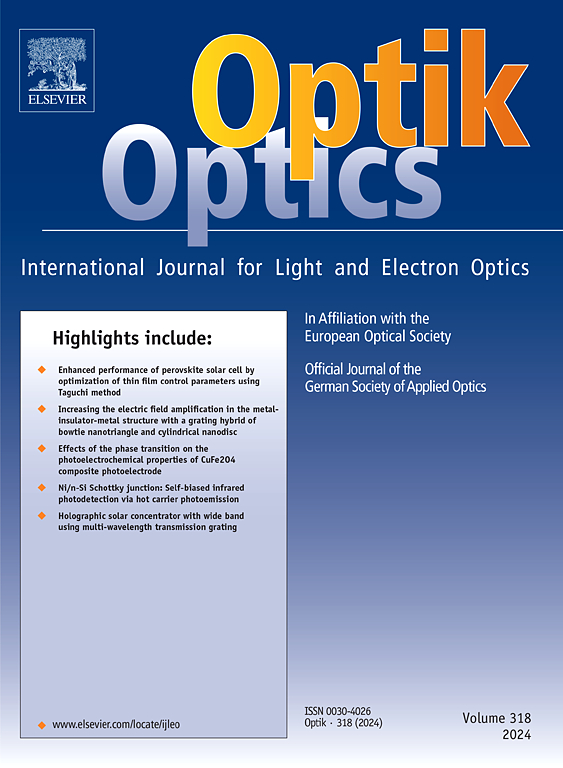Design and simulation of band stop plasmonic filter with high quality factor and enhanced optical performance
IF 3.1
3区 物理与天体物理
Q2 Engineering
引用次数: 0
Abstract
In this paper, we present the design and performance of a band-stop plasmonic filter incorporating a triangular resonator and a central circular cavity within a Metal-Insulator-Metal (MIM) waveguide configuration. The filter operates based on Surface Plasmon Polaritons (SPPs), which are excited at the metal-dielectric interface, allowing for a compact design with excellent optical performance. The filter design was optimized through a combination of numerical simulations using the Finite Difference Time Domain (FDTD) method and theoretical analysis. The simulation results indicate that the filter achieves a high-quality factor of 272 at a resonance wavelength of 818 nm and a cavity width (d) of 35 nm, significantly outperforming previously designed filters. Additionally, the paper presents a detailed comparison of the plasmonic performance of silver and gold, examining their effects on the quality factor, transmission spectrum, resonance wavelength, and overall optical performance. The results highlight that the choice of material plays a crucial role in optimizing the filter’s characteristics, as silver demonstrates a higher-quality factor and sharper resonance compared to gold. The filter's high-quality factor provides excellent wavelength selectivity and suppresses unwanted interference effectively, ensuring efficient performance. Moreover, the proposed structure exhibits a small full width at half maximum (FWHM) and tunable resonance wavelengths through precise control of geometric parameters such as cavity dimensions and resonator shape. These tunable characteristics make the filter highly suitable for advanced photonic applications, including optical filtering, high-speed communication systems, and biosensing. The significant results of this study confirm that the proposed plasmonic filter structure is a promising candidate for future nanophotonic systems, where high efficiency and precise wavelength control are essential.
具有高品质因数和增强光学性能的带阻等离子体滤波器的设计与仿真
在本文中,我们提出了一种带阻等离子体滤波器的设计和性能,该滤波器在金属-绝缘体-金属(MIM)波导结构中包含三角形谐振器和中心圆形腔。该滤波器的工作原理是基于表面等离子激元(SPPs),它在金属-介电界面被激发,使得设计紧凑,光学性能优异。通过时域有限差分法(FDTD)数值模拟和理论分析相结合的方法对滤波器设计进行了优化。仿真结果表明,该滤波器在谐振波长为818 nm、谐振腔宽度(d)为35 nm时的高质量因数为272,显著优于先前设计的滤波器。此外,本文还详细比较了银和金的等离子体性能,考察了它们对质量因子、透射光谱、共振波长和整体光学性能的影响。结果强调,材料的选择在优化滤波器特性方面起着至关重要的作用,因为与金相比,银表现出更高的质量因子和更锐利的共振。该滤波器的高质量因数提供了出色的波长选择性,并有效地抑制了不必要的干扰,确保了高效的性能。此外,该结构具有较小的半最大值全宽(FWHM)和可调谐的谐振波长,通过精确控制谐振腔尺寸和谐振腔形状等几何参数。这些可调特性使滤波器非常适合先进的光子应用,包括光学滤波,高速通信系统和生物传感。本研究的重要结果证实,所提出的等离子体滤光器结构是未来纳米光子系统的一个有希望的候选者,其中高效率和精确的波长控制是必不可少的。
本文章由计算机程序翻译,如有差异,请以英文原文为准。
求助全文
约1分钟内获得全文
求助全文
来源期刊

Optik
物理-光学
CiteScore
6.90
自引率
12.90%
发文量
1471
审稿时长
46 days
期刊介绍:
Optik publishes articles on all subjects related to light and electron optics and offers a survey on the state of research and technical development within the following fields:
Optics:
-Optics design, geometrical and beam optics, wave optics-
Optical and micro-optical components, diffractive optics, devices and systems-
Photoelectric and optoelectronic devices-
Optical properties of materials, nonlinear optics, wave propagation and transmission in homogeneous and inhomogeneous materials-
Information optics, image formation and processing, holographic techniques, microscopes and spectrometer techniques, and image analysis-
Optical testing and measuring techniques-
Optical communication and computing-
Physiological optics-
As well as other related topics.
 求助内容:
求助内容: 应助结果提醒方式:
应助结果提醒方式:


